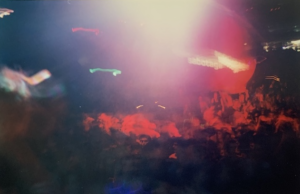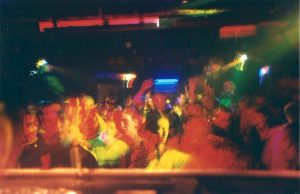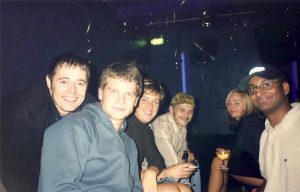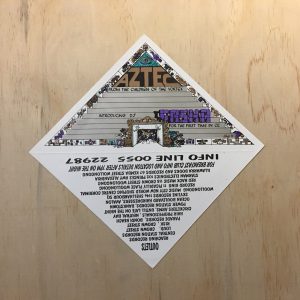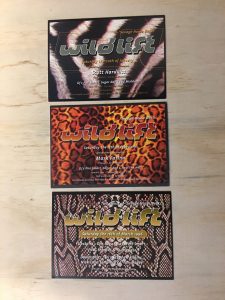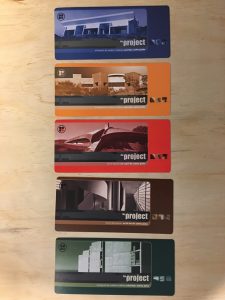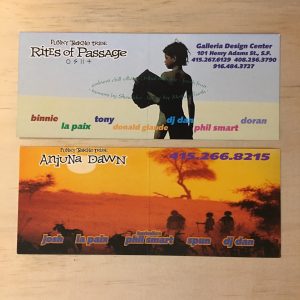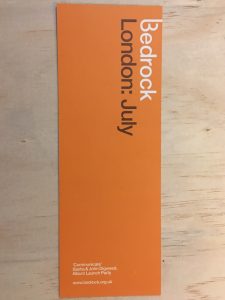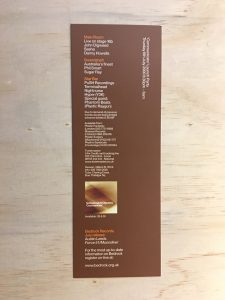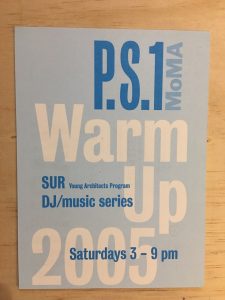Photo credit: Chantelle Grady
The image that many people have of a DJ is someone playing to a heaving dancefloor on a big sound system with lots of flashing lights, the crowd with their hands in the air with every big drop.
But there’s another, less glamourous (but no less important) side to DJing that many forget about, the guys and girls in the corner of a bar, playing music to drink to. Sure, the energy may whip up a little spontaneous dancefloor now and then, and there are a few dance bars around, but more often than not it’s just a certain kind of audio wallpaper, and it takes a particular type of selector skills to put together that sort of soundtrack.
Way better than a Spotify playlist on shuffle that comes complete with gaps in between tracks, this is the human, programmed-in-the-moment playlist, following the ebb and flow of time and place, and feeding back in real time.
Often it’s early in the night, the kind of place people might meet and gather before heading out somewhere else. Sometimes, it’s after work drinks with colleagues. And then there’s the occasional bar crawl that can provide a humorous interlude for the DJ, especially valuable as bar DJs tend to play much longer sets than most club DJs, often between 4-6 hours.
Some of the best bar DJs have been doing it a long time too, and bring with them a wealth and depth of musical knowledge that is expressed through their music selection. One DJ I know from Sydney is in his early 60s and has been playing since forever, and he reckons that the younger bartenders often express to him their appreciation for this aspect of listening to his curated selections in their bars.
As for the setups, well the DJ booths are often squeezed into odd spots, and plenty of them are actually located behind the bar, like at Killing Time in Melbourne and Super Whatnot in Brisbane, and I’ve had my fair share of drunken punters try and order a drink from me.

Photo credit: Chantelle Grady
The equipment isn’t always the greatest either, and the monitoring can be sub par, but then again there’s often not a lot of mixing going on either. Playing in bars relies more heavily on the programming and track selection than on holding a three minute mix to try and take the (usually non-existent) dancefloor to the next level.
Another side effect of the DJ booths’ generally more accessible location behind the bar, coupled with the greater informality than a club and the lower music volumes, means that some of the traditional barriers between the DJ and the aforementioned drunken punter are lowered, resulting in an exponential increase in the request factor.
Musically it can be a lot more diverse, as you’re not necessarily trying to hold that dancefloor, and it’s a great opportunity to mix up genres and BPMs. Funk and soul are staples, as is old school hip hop, and the 80s gets a good showing too. Personally I also mix in a lot of instrumental hip hop and downtempo, dub and reggae, loungecore, classic rock, nu disco, post punk and Balearic. The mixing can be a lot more choppy as you blend genres, drop in live tracks, short tracks and the ones with strange intros, and you find that you have to ride the levels a lot more to go along with the natural ebb and flow of people and conversations coming and going, responding to vibes and reading the room. It also helps if you’ve got cool bar staff with good taste, who know how to set the right mood before and/or after you play, because quite often there won’t be DJs playing the whole time the bar is open either.
The crowd can often be just as diverse as the music too, with suits and hipsters, tourists and locals all sharing the stools and booths of the bar. This presents its own challenges for the selector, as who’s into what can be less clear by looking at the crowd, particularly at CBD bars where work attire is involved, and not having a niche crowd like you often get at a lot of clubs means you have to navigate a completely different kind of musical journey. This keeps it fun and interesting though, and I learnt early on that you can’t please everyone all the time, so try and find a balance of eclectic diversity that you feel works for the room, and always chuck in something that can connect to that one person in the bar that’s not particularly into music and got dragged there after work;)
Ultimately, your job as a bar DJ is to keep the patrons entertained enough so they stay longer than they would if an iTunes playlist was playing, almost without being noticed, meaning creating an enjoyable atmosphere where they can still hold a conversation, dropping enough tracks here and there that get their interest and a nod of recognition. Tapping of the foot against the bar stool is a good sign, as is a bit of chair dancing. My favourite brief for DJing a bar was from Simon, the owner at Super Whatnot, who essentially said to me “just play eclectic music that they wouldn’t have heard on the radio that day”.
Don’t just take my word for it, I put some questions to three more veteran bar DJs to hear what they had to say…
JIMMY ELLIS (Brisbane)

How long have you been playing bars?
18 years
Where you playing now?
I’m only really playing one bar regularly at the moment, Super Whatnot in Brisbane CBD, as I’m trying to keep my DJ work more focused.
What was/is your favourite bar to play ever?
I love playing at Super Whatnot because you’re attached to the bar and can enjoy the company of the excellent bar staff.
What do you like about DJing in bars, and how do you approach it differently to DJing for a dancefloor?
I treat bar gigs as more of an exercise in music selection. I’ll keep mixing down to a minimum and quite often not mix at all. To me it’s more important to choose appropriate music than worry about being really technical.
What’s the toughest thing about spinning in bars?
They are usually quite long shifts, so it can be a challenge to stay focused in a bar setting and stay on your feet for 4 hours. It’s also pretty easy to leave a long shift very drunk if you have an accommodating bar tab.
Vinyl or Digital or both?
Who cares?
What styles rule for you in bars?
Downtempo, electronica, 80’s boogie, movie soundtracks
Crazy request story…
Pretty sure any DJ that’s been around for a while could write a book. Pretended to have a girl ejected from a venue for asking for Abba.
5 records that never leave your box (virtual or otherwise)
Vangelis – Blade Runner OST
Sade – Hang On To Your Love
Sharon Redd – Never Give You Up
Frank Hooker & Positive People – This Feelin’
Beloyd – Today All Day
Jimmy’s Soundcloud
———————————————————————————————————————————————–
DJ FILTHYRICH AKA DADDYRICH (Adelaide)

How long have you been playing bars?
Clubs for 30 years, bars for the last 10 years as there has been a shift in the culture.
Where you playing now?
Bank Street Social, Udaberri and the Earl of Leicester in Adelaide
What was/is your favourite bar to play ever?
AKA London (the End) and new favourite Bonobo in japan.
What do you like about DJing in bars, and how do you approach it differently to DJing for a dancefloor?
It’s more about dancing minds creating a quiet storm and atmosphere, with blends to keep tempo changing and paying close attention to the volume, allowing people to talk and not shout.
What’s the toughest thing about spinning in bars?
Not having a booth to keep people away from my vinyl
Vinyl or Digital or both?
Vinyl
What styles rule for you in bars?
No music played on the radio, keeping a musical story. Playing reggae, dub, soul, funk, jazz, b-boy breaks, early hip hop, underground disco and soul, original house and staying true to me and my style.
Crazy request story…
Not ones I can share (rated R)
5 records that never leave your box (virtual or otherwise)
Various – Strange Game and Things
The Equals – Funky Like A Train
Crue-L – Grand Orchestra
Rey De Copas – Frontera Del Ensueno
Barrington Levy – Here I Come
Rich’s Soundcloud
———————————————————————————————————————————————–
DEAN DIXON (Bali/Sydney)

How long have you been playing bars?
I pretty much started playing in bars from almost the very beginning really, because I literally started to learn how to DJ the week before the first party I ever put on in an old RSL hall. That party segued into a wee series of events in various odd vacant spaces in a tiny town way up north in Canada where I was working at the time. It was around the year 2000 or so, the year after I graduated Uni, and then I played just primarily bars for a long time after that small series of events. So that’s a decent chunk of time ago now!
Where you playing now?
I hold a number of different residencies over here in Bali at the moment including; Potato Head Beach Club, Rock Bar, W Hotel, Karma Beach Club, 40 Thieves, Mama San and other places as well. Plus I’m also over in Singapore pretty often playing at the Potato Head there or Tanjong Beach Club or the W Hotel.
What was/is your favourite bar to play ever?
My favourite bar to ever play at would have to be Potato Head Beach Club here in Bali. Simply because you get to play such a wide variety of music during so many different times of the day to such a wide variety of the population and because its location and architecture are so supreme. The grassy, amphitheatre-esque layout, complete with a massive lap pool right on the beach at the edge of the ocean with a wide open music policy which allows you the freedom to showcase a lot of different genres of music and create some really special moments. It’s a real wild combination.
But in all honesty, its a tough question. Because I’ve been fortunate enough to play at so many amazing spaces over the years and more recently some extremely awe inspiring spots. Like Rock Bar for example would have to be a dead set second for me. It’s also sat right at the edge of the coastline but perched up on the rocks with100% unobstructed views of the sunset across the horizon of the ocean as well, but in this case that view is from nearly every seat in the venue!
So, timing the music to the setting of the sun at either of these places can make for some really extremely special moments for people… I mean, I’ve personally witnessed like 5 or 6 proposals at Rock Bar since I started my residency down there. How could she say no?! Hahaha
What’s the toughest thing about spinning in bars?
I think the toughest thing is the lack of immediate and direct feedback you get from having less audible and visual cues to assess with each track you play or each nudge of the volume or twist of the EQs. It can be tough and it can come down to even the most simple and subtle mannerisms of the patrons, their facial expressions or toe tapping or clapping to the beat, things like that.
What do you like about DJing in bars, and how do you approach it differently to DJing for a dancefloor?
Playing in bars I think is generally a bit more difficult because of the lack of immediate feedback from body language and such. I enjoy it a lot though because you often get to play more across the board and stretch your legs more freely as a DJ simply because you have to in order to keep more people interested and also because you often have more time to do so because your set time is generally longer. I also like how people feel more inclined to come and talk to you during your set to say they like it or to ask about a particular piece of music you played or even to ask what “kind” of music you’re playing because people don’t know what genre it is you’re even playing because it might be so left of centre. But that same ease of approachability is also a double-edged sword and can work in the opposite way as well, as we all know! Hahaha
With regards to how I approach a bar set as opposed to a DJ set, I’d say I do so in the exact same manner. I think about the time of day or night I have to play, what type of event or bar it is, what type of crowd I might be thinking to expect or even what DJ I might be playing before and after so I can consider how best to start or finish. Basically, the more info you can get ahead of time about the event or bar you’re booked to play at the more accurately you can pre-select tracks to stick in our bag or “virtual bag” that you feel might create certain impacts in various ways at different times throughout your set or what you think might work well.
I really enjoy trying to create special moments for the listeners and I might do that by selecting tracks that might have a more nostalgic feel or create certain emotions at certain times, or a few tracks that line up well one after another. I never have and never will pre-program a set though, so don’t get me wrong. I prefer the spontaneity of selecting on the fly because I feel that once you learn to do it well, you can really do a great job at working with the vibe of the place and the people in the room simultaneously as you go and that enables you to create really special moments in time when you do it really, really well. It doesn’t always work. But when it does, it’s the best feeling. The world just clicks into place and everyone in the room seems to spin together for just a little while.
Vinyl or Digital or both?
I prefer vinyl as a medium based on a few things. Personally, I’m very tactile and I enjoy manipulating a record to speed it up and slow it down very slightly with your hand on the platter as two records shuffle, to create certain subtle nuances that I don’t believe you can achieve as well with a digital format in exactly the same way.
I also prefer vinyl because I’m a very visual person with regards to my memory. So things like the cover art on the sleeve, the sticker on the record, the sticker I might add to the record and what I might write on the sticker itself. Each of those things and more used to help me to remember certain tracks and select them with a few seconds notice from out of a stack which enabled me to create special moments really rapidly and I just don’t feel that I’m able to work with the same sort of effectiveness as frequently in the digital format. But that’s simply because my mind doesn’t remember things the same way in the digital format… regardless of whether I have a tiny jpeg of the album cover linked to a song, or whether I create a track note for a song or whatever. It’s just never going to be the same for me playing digitally verses playing strictly vinyl. There are benefits to playing digitally as well though of course. Being able to have so much music available to you at the drop of a hat without breaking your back and being able to create loops and sort of create edits on the fly are exciting benefits for me when DJing digitally, but having too much music at your disposal is also a double edged sword.
Which leads me into the other aspect about vinyl that I really miss since going pretty much solely digital since moving to Bali. And that’s the extremely specific selection process that a vinyl DJ goes through prior to every single gig as opposed to that of a digital DJ…. generally speaking of course. A vinyl junkie for example will select records for a set based on many things he will know about the gig they have lined up and then they’ll go through the selection process again and again to narrow the records they choose down more and more, simply because you cannot carry all your records to a gig. And its that very simple, fundamental conundrum which creates a special situation…. it forces the selector to be extremely specific with his/her choices of what to bring with them and that provides the listener on the night with an equally special situation because of all the tiny nuances that the selector will feel out prior to getting there and then also throughout the night….those nuances will all determine which of these extra carefully selected records he or she may play at specific times throughout the set, and that can then lead to the creation of some really intensely special moments for everyone involved, if the selector knows what they’re doing, and the venue and the crowd provide them with the freedom with which to do so.
And I just don’t believe that that happens nearly as often in the digital domain mainly because the ability to have access to so much music at once will quite often make a person lazy and feel less inclined to prepare as much when selecting music for a given set. Which is a generalisation of course, but that’s just my thoughts.
But over here in Bali the climate simply isn’t kind to vinyl or the turntables and needles themselves, so it’s not really the best conditions for using it as a primary medium. In an ideal situation however, I think that nowadays I’d use both mediums in every set I played given the opportunity.
What styles rule for you in bars?
I don’t often play any single style or genre at any of the gigs I play at really, despite perhaps having to play more so one way or another at a certain venue. For example, a bar might ask that the DJs play more 4×4 stuff or when I’m given a specific brief that pushes you to play more Afro and world music related vibes for example. But even then, I still always strive to throw in other bits throughout my set that also work really well alongside the other stuff briefed because I believe music provision, much like any other vocation, should be a learning experience for people partaking in it for the listener as much as it is for the provider of it. And I enjoy exposing people to really amazing music or assisting them to hear things that they might never be presented with if they were always listening to the same stuff. More specifically though, I’d say that the genres I choose to play when I’m given an open brief really depends on a few key simple things. For example, the type of venue I’m booked to play at, the time of day that I’m booked to play. It even comes down to who I might be playing before or after, or what music the DJ before me is playing and how I feel that music is working at the time, to even what music the venue has chosen for their playlist when I get there and how I feel that works in the space while I’m in the venue before playing. There are an awful lot of little things that I assess to try to do the best job I can even before I start to help me play as much different music as I can to the best of my ability.
Crazy request story…
I recently had a drunk old Aussie guy at a party try to trade me his phone for “playing something good”….. Too bad it was a shit phone or maybe he would have gotten his request! Hahaha. Anyhow, later on at the end of the night when I’d finished my last track and the venue had just been heaving and crowd had just been chanting for more…the guy came back up to me to shake my hand and told me that I wasn’t so shit after all!… I keep kicking myself for not asking for his phone just for the hell of it! HAHAHA
5 records that never leave your box (virtual or otherwise)
There is just way too much amazing music that I’ll always play forever, but here are five that have meant something special to me.
Jamie Principle – Waiting For My Angel
Arthur Russell – This Is How We Walk On The Moon
Oumou Sangare – Djoukourou (Auntie Flo remix)
Joubert Singers – Stand on the Word (Celestial Choir Unreleased Larry Levan Mix)
Shina Williams and his African Percussionists – Agboju Logun
Dean’s Soundcloud
Typed/Questioned by Phil Smart • January 2019
Phil’s Soundcloud


